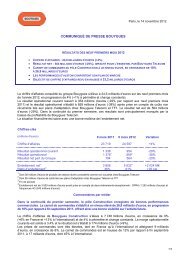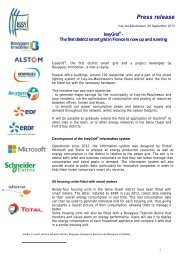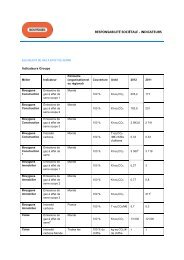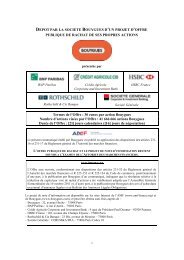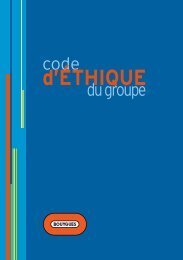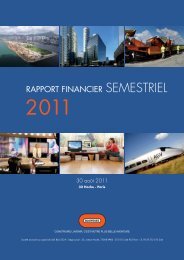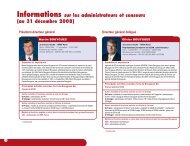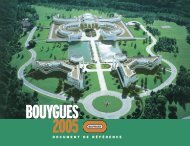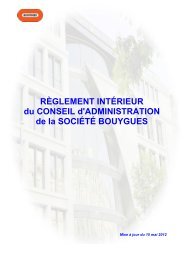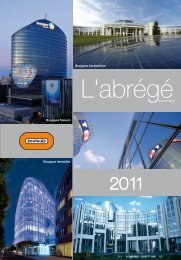A N N U A L R E P O R T - Bouygues
A N N U A L R E P O R T - Bouygues
A N N U A L R E P O R T - Bouygues
Create successful ePaper yourself
Turn your PDF publications into a flip-book with our unique Google optimized e-Paper software.
The main initial allocations of acquisition cost to<br />
identifiable assets and liabilities may be adjusted<br />
within the twelve months following the acquisition<br />
date, after which they may no longer be<br />
adjusted.<br />
Goodwill recognised prior to 1 January 2004,<br />
which <strong>Bouygues</strong> elected not to restate under<br />
the option allowed by IFRS 1, continues to be<br />
measured using the partial fair value method<br />
(IFRS 3). This method involves restricting the<br />
fair value remeasurement of identifiable items<br />
to the percentage interest acquired. Minority<br />
interests are measured at the carrying amount<br />
of such items as shown in the balance sheet of<br />
the acquired entity.<br />
Negative goodwill is taken to the income statement<br />
in the period in which the acquisition is<br />
made.<br />
Subsequently, goodwill is carried at cost net of<br />
any impairment losses identified using the methods<br />
described under “Subsequent remeasurement<br />
of non-current assets” below, in accordance<br />
with IAS 36. Impairment losses are charged to the<br />
income statement as an operating item.<br />
2.4. Foreign currency<br />
translation<br />
2.4.1. Transactions denominated in<br />
foreign currencies<br />
Transactions denominated in foreign currencies<br />
are translated into euros at the average<br />
exchange rate on the date of the transaction.<br />
Monetary assets and liabilities denominated in<br />
foreign currencies at the balance sheet date<br />
are translated at the closing exchange rate.<br />
Translation differences are recognised as income<br />
or expenses in the income statement. Non-monetary<br />
assets and liabilities denominated in foreign<br />
currencies and accounted for at historical cost<br />
are translated using the exchange rate on the<br />
date of the transaction.<br />
2.4.2. Financial statements of<br />
foreign entities<br />
All assets and liabilities of consolidated entities<br />
with a functional currency other than the euro<br />
are translated at the closing exchange rate.<br />
Income and expenses are translated at the average<br />
exchange rate for the period. Translation differences<br />
arising from this treatment, and arising<br />
from the retranslation of a subsidiary’s opening<br />
shareholders’ equity at the closing exchange<br />
rate, are taken to the translation reserve, which is<br />
a component of “Share premium and reserves” in<br />
shareholders’ equity. Translation differences arising<br />
on the net investment in foreign subsidiaries<br />
and associates are recognised in shareholders’<br />
equity.<br />
2.5. Deferred taxation<br />
Deferred taxation is recognised on differences<br />
between the carrying amount and tax base of<br />
assets or liabilities, and arises as a result of:<br />
• Temporary differences between the carrying<br />
amount and tax base of assets or liabilities,<br />
which may be:<br />
- items generating a tax liability in the future<br />
(deferred tax liabilities), arising mainly from<br />
income that is liable to tax in future periods;<br />
or<br />
- items deductible from taxable profits in the<br />
future (deferred tax assets), mainly provisions<br />
that are temporarily non-deductible<br />
for tax purposes.<br />
• Tax losses available for carry-forward (deferred<br />
tax assets), provided that there is a genuine<br />
probability of recovery in future periods.<br />
Deferred taxes are measured using known applicable<br />
tax rates at the balance sheet date. In the<br />
case of French entities, deferred tax assets have<br />
been adjusted to reflect the effect of changes in<br />
tax legislation and of new tax rates.<br />
Deferred taxes are not discounted.<br />
Deferred tax assets are included in non-current<br />
assets.<br />
2.6. Non-current assets<br />
2.6.1. Property, plant and equipment<br />
Property, plant and equipment is measured at<br />
acquisition cost net of accumulated depreciation<br />
and impairment. Depreciation is recognised on a<br />
straight line basis over the estimated useful life<br />
of the asset.<br />
Useful lives by main asset category and business<br />
segment:<br />
Mineral deposits (quarries)<br />
(1)<br />
CONSTRUCTION MEDIA TELECOMS<br />
Non-operating buildings 10 to 30 years 25 to 50 years -<br />
Industrial buildings depends on type - 20 years<br />
Plant, equipment and tooling 3 to 10 years 3 to 7 years 3 to 10 years<br />
(2)<br />
Other property, plant and equipment<br />
(vehicles and office equipment)<br />
In accordance with IAS 16, when an item of property, plant and<br />
equipment consists of components with different useful lives, each<br />
component is accounted for and depreciated as a separate item, in<br />
terms of the estimated terminal residual values and depreciation<br />
calculations.<br />
Gains and losses on disposal represent the difference between<br />
the sale proceeds and the carrying amount, and are recognised in<br />
the income statement under “Non-current operating income and<br />
expense”.<br />
(1) depreciated on the basis of the rate of depletion,<br />
up to a maximum of 40 years<br />
(2) depending on the type of asset<br />
3 to 10 years 2 to 10 years<br />
(2)<br />
Depreciation periods are reviewed annually, and<br />
are adjusted if expectations differ from previous<br />
estimates. The resulting changes in accounting<br />
estimate are accounted for prospectively.<br />
160



